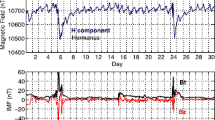Abstract
An elliptical wind field model of typhoons is put forward based on the characteristics of the typhoon wind fields occurring in the Yellow Sea and Bohai Sea. By contrasting it with the circular typhoon wind field model, it is found that the elliptical model can adequately represent the real wind field and trace the process of a typhoon storm surge. The numerically simulated results of storm surges by using the elliptical model are in good agreement with the observations and markedly better than those by using the circular model.
Similar content being viewed by others
References
Chen, K. M., 1994. A computation method for Typhoon wind field. Tropic Oceanology, 13(2): 41–48.
Ding, W.L., and Liu, F.S., 1987. Numerical simulation on typhoon surge and surge estimation of Huanghe River Estuary region in Bohai Sea. Oceanologia et Limnologia Sinica, 18(5): 481–490 (in Chinese with English abstract).
Jelesnianski, C.P., 1965. A numerical computation of storm tides induced by a tropical storm impinging on a continental shelf. Mon. Wea. Rev., 93(16): 343–358.
Jelesnianski, C. P., 1966. Numerical computation of storm surges without bottom stress. Mon. Wea. Rev., 94(6): 374–379.
Jelesnianski, C. P., 1967. Numerical computation of storm surges with bottom stress. Mon. Wea. Rev., 95(11): 740–756.
Leendertse, J.J., 1967. Aspects of a computational model for long-period water wave propagation. The Rand Corporation, RM-5294-PR.
Mathur, M. B., 1986. Application of quasi-Lagrangian model to hurricane prediction. DWMO/IUGG International Symposium on Short and Medium Range Numerical Weather Prediction, Tokyo, 461–464.
Mathur, M.B., 1991. The national meteorological center’s Quasi-Lagrangian model of Hurricane prediction. Mon. Wea. Rev., 119: 1419–1447.
Mathur, M. B., 1997. Development of an eye-wall like structure in a tropical cyclone model simulation. Dynamics of Atmospheres and Oceans, 27: 527–547.
Minato, S., 1996. Numerical simulation of tide and storm surges in the Seto Inland Sea using the Princeton Ocean model. Papers in Meteorology and Geophysics, 47(2): 103–114.
Miyazaki, M., T. Ueno, and S. Unoki, 1962. Theoretical investigations of typhoon surges along the Japanese coast (II). Ocean. Mag., 13(2): 103–117.
Mu, H.Z., and Tu, Q.P., 2000. Climatological characteristics of tropical cyclone activities in the west Pacific. Journal of Nanjing Institute of Meteorology, 23(1): 81–86 (in Chinese with English abstract).
Sheng, L.F., and Wu, Z.M., 1993. A new fitting method for sea surface wind field of Typhoon. Journal of Tropical Meteorology, 9(3): 265–271 (in Chinese with English abstract).
Smith, S. D., 1980. Wind stress and heat flux over the ocean in gale force winds. J. Phys. Oceanogr., 10: 709–726.
Tang, Y., and R. Grimshaw, 1995. A model analysis of coastally trapped waves generated by tropical cyclones. J. Phys. Oceanogr., 25: 1577–1598.
Tang, Y., R. Grimshaw, B. Sanderson, and G. Holland, 1996. A numerical study of storm surges and tides, with application to the North Queensland coast. J. Phys. Oceanogr., 26: 2700–2711.
Tang, Y., G. Holoway, and R. Grimshaw, 1997. A numerical study of the storm surge generated by tropical cyclone Jane. J. Phys. Oceano., 27: 963–976.
Wang, J. Y., 1985. A numerical prediction model of storm surge in the East Chinese Sea. Journal of Ocean College of Shandong, 15(3): 40–47 (in Chinese with English abstract).
Wang, X.Q., and Wang, J. Y., 1997. The Calculation of Maximum Elevation due to storm surge by using joint probability method. Mausam, 48(4): 587–594.
Wang, X.Q., Qian, C.C., and Wang, W., 2001a. The influence of selected calculation field on the simulation of storm surges. Journal of Ocean University of Qingdao, 31 (3): 319–324 (in Chinese with English abstract).
Wang, X.Q., Qian, C.C., and Wang, W., 2001b. Test of influence of wind drag coefficient on Typhoon storm surge simulations. Journal of Ocean University of Qingdao, 31(5): 640–646 (in Chinese with English abstract).
Xie, H. Q., Gao, S. H., Sheng, L. F., and Wu, Z. M., 2001. A diagnosis model of Typhoon surface winds in coast and estuary regions. Journal of Ocean University of Qingdao, 31(5): 651–658 (in Chinese with English abstract).
Zhang, Y.T., and Wang, Y.J., 1983. Numerical simulation of wind field and storm surges in Bohai Sea. Acta Oceanologica Sinica, 5(3): 261–272 (in Chinese with English abstract).
Zhou, X.B., and Sun, W.X., 2000. The non-linear interaction between storm surges and astronomical tides in the sea area off river Changjiang’ s mouth. Journal of Ocean University of Qingdao, 30(2): 201–206 (in Chinese with English abstract).
Zhu, S.X., Sha, W.Y., Ding, P.X., and Chen, X., 2002. An asymmetry wind field model of Typhoon near shore. Journal of East China Normal University (Natural sciences), (3): 66–71 (in Chinese with English abstract).
Author information
Authors and Affiliations
Rights and permissions
About this article
Cite this article
Wang, X., Qian, C., Wang, W. et al. An elliptical wind field model of typhoons. J Ocean Univ. China 3, 33–39 (2004). https://doi.org/10.1007/s11802-004-0005-z
Received:
Accepted:
Issue Date:
DOI: https://doi.org/10.1007/s11802-004-0005-z




